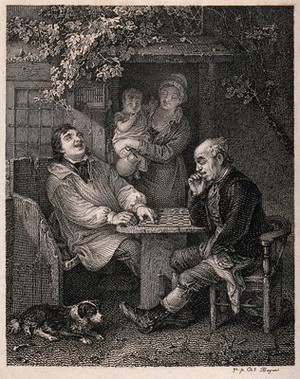
Draughts
Draughts is the pre-cursor to modern checkers. Although modern checkers is played on an 8x8 "chequered pattern" board, draughts was commonly played on a 10x10 or 12x12 board. The board is arranged so that a "black" (or the darker of the colored) square is in the lower left corner as viewed by the players.
Draught pieces called "men" were made of various materials, including bone, wood, or stones. Although the color of the pieces & the board do not necessarily need to be black & white, they are normally referred to as black & white, regardless.
Pieces are arranged on the dark colored squares, one piece to a square in the three rows closest to the players. The white squares are not used at all in the game. Depending on the size of the board, 12-18 men per player are required. The objective of the game is to take all of the opponent's pieces or to produce a position such that the opponent is unable to move.
Play:
Black always plays first. Players take turns to move a piece of their own color. All pieces move & attack only on the diagonal. Until crowned, any man may move only one space at a time (unless attacking, noted below). When a piece reaches the far edge of the board is immediately crowned & is thereafter known as a "King". The act of crowning is a physical one - another piece of the same shade is placed on top of the piece in order to distinguish it from an ordinary piece. Once a piece is "crowned", it can move as many empty squares on a diagonal to capture an opponent’s man.
Whenever a piece has an opponent's piece adjacent to it & the square immediately beyond the opponent's piece is vacant, the opponent's piece can be captured. If the player has the opportunity to capture one or more of the opponent's pieces, then the player must do so. A piece is taken by simply jumping over it into the vacant square beyond & removing it from the board. Unlike an ordinary move, a capturing move can consist of several such jumps - if a piece takes an opponent’s piece & the new position allows it to take another piece, then it must do so straight away. The move finishes only when the position of the capturing piece no longer allows it to take any more pieces or when an uncrowned piece arrives at the far edge of the board & is crowned. Both crowned & uncrowned men may attack either forwards or backwards.
If more than one piece can capture, then the player is entirely free to choose which of those pieces to move. Likewise, if a capturing piece is able to capture in more than one direction, the player is free to choose which direction to move in. It is not required to move the piece or take the route that will result in the maximum number of captures. If no capturing moves are available, then an ordinary move is made by moving a piece one square diagonally.
If a player notices that the opponent failed to capture when the option was open (even if the offending piece had already captured one or more pieces that turn), the player can "huff" the offending piece before the next move is made & it is removed from the board.
